Sailing trip: 7 days in the Stockholm Archipelago | June 2014 | Yacht: Arcona 340
Saturday, 14th June
During the approach to Stockholm airport the cloud cover breaks up and we can see our sailing area for the next week. Narrow passages and larger expanses of water built an endless labyrinth with the innumerable islands. We land about 25 miles in the north of Stockholm at the Arlanda Airport. From there we reach the city centre with the Arlanda Express train in half an hour. Everything is relaxed and the Swedish people are friendly and very helpful. They immediately speak English when they realise that one does not master their language. Any payment process – be it for the train or bus ticket or even for a chocolate bar – is all done by credit card.
Our destination is a small suburb in the southeast of Stockholm called Gustavsberg. There the shipyard is located that just delivered the brand new Arcona 340 yacht on which we are invited to sail the next week. From the main station we take the underground to Slussen. That is the lock that separates the freshwater of Lake Mälaren from the saltwater of the Baltic Sea. We go on by bus towards Hemmesta through the hilly landscape that is overgrown with birches and pines.
When we get off the bus a strong wind from the north whistles around our ears. It is sunny though, but cold. Gustavsberg was once the centre of the Swedish porcelain industry. In the former factory buildings from the early 20th century a museum is located these days. We follow the water to the marina of the Arcona shipyard where our skipper and owner of the yacht expects us on the jetty.
Unfortunately he tells us that we will not leave the dock today. The wind from the north already blows with 6 wind forces and will increase till the evening. Only by early afternoon tomorrow sailing might be possible again. So we have time to unpack our things in peace and to get to know the ship. But first we have to see the real attraction of Gustavsberg: The bakery with its café! Exceptionally pretty, mainly blond, unbelievable friendly sales assistants stand behind the counter on which the most delicious pieces of cake are stacked. When we see all these goodies we are speechless. But for our skipper this is a common sight already and so he orders coffee and a Kanelbullar (cinnamon bun) for each of us. And his decision turns out to be perfect. The next stop is the Hemsköp, the local supermarket. There we buy our groceries for the whole of the next week because on the small islands where we want to go to it is hard to get something. And if at all it is very limited. After that we visit the Systembolaget, the state-owned alcohol shop, because the supermarket is only allowed to sell light beer. Heavily loaded we reach the yacht, unpack our things and then we go to the nearby bistro for lunch.
At the counter we are once again welcomed by a friendly young woman. She looks like the Swedish crown princess, but much more attractive. We are old geezers but she gives each one of us the feeling to be something special. She laughs charmingly and persuades us to take her most expensive dishes. But anyway it is a feast for the eyes as well. The food is substantial and tastes good. We are surrounded by families with kids, pensioners and middle aged couples who are talking lively in their melodically spoken language. There is a pleasant and jolly atmosphere.
After lunch we have a little rest. To properly wake up afterwards we visit the bakery for a second time. The caffeine in the coffee and the adrenaline when we see the bakers achieve the required result. Strengthened by a piece of cake we head back so that our skipper can let us into the yacht’s secrets.
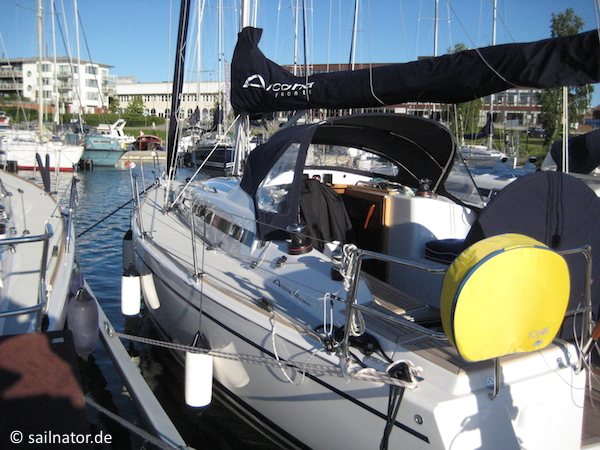
Arcona 340 in Gustavsberg
But where should we start? Best with a basic device that everybody uses eventually: the toilet. Ours has a manual operated pump as it is typical on yachts. But it is always good to see how it works after a long time. And on the Arcona 340 the feeding seacock is not located under the sink as usual, but in the bilge. So the pump works even when the boat heels. But you have to open the valve before you enter the bathroom. Furthermore the wastewater goes straight in the black water tank without the possibility to pump it directly into the sea. With 50 litres the tank is not really big for a crew of 3 men. Because of that one has to think about emptying the tank early enough. If it is too full the wastewater might get into the bleed valve and it might clogg up. If this happens it is not possible to use the pump anymore.
In front of the bathroom on starboard the navigation table is located. Because of that we continue here with the briefing: How does the electric panel works? Where are the switches for every single electrical device? The bilge pump gets some special attention. It is connected to the same electrical distributor as the wastewater pump for the shower. But there is an extra switch in the bathroom that can accidentally be turned on very easily. So when the bilge pump does not work even if switched on at the electric panel one should search for the cause in the bathroom. This is a very important piece of information in case of emergency.
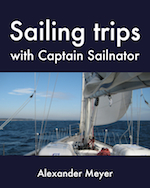 My sailing trips have also been published as ebook and paperback. For more information click here!
My sailing trips have also been published as ebook and paperback. For more information click here!
You can download the Ebook for example at:
iTunes UK & iTunes US | iBooks for iPad and Mac
Amazon.com & Amazon.co.uk | Kindle-Edition
Google Play | for Android
The paperback is available at: Amazon.com | Amazon.co.uk
Under the navigation table the main switch for the consumer batteries is to be found. The one for the starter battery is in the aft cabin. Where are the signal horn, the portable spotlight, the torch, the fire blanket, the fire extinguisher, and where are the tools? Where is the first aid box and what is included for which injury. Where are the fresh water tank and hot water boiler? Where could a leakage be, if there is freshwater in the bilge? And what in the case of salt water? So we check all the seacocks. We look for the valve in the bathroom, the valve under the sink in the galley and the ones in the engine compartment. We search the hull fittings for the depth sounder and the log.
Then we devote our attention to the gas stove. The gas bottle is located in the anchor locker at the bow. It has to be unscrewed before and tightened after cooking. And directly at the stove there is another valve. How does the electric ignition work? Again we remember where the fire blanket and the fire extinguishers are located. How does the cardanic suspension open and close? How are pots and kettles best protected from falling off the stove?
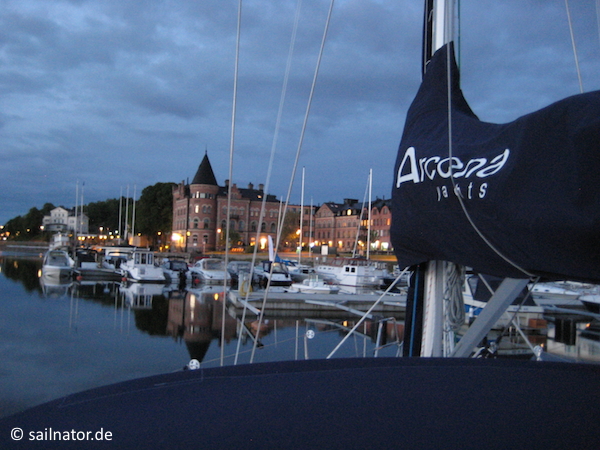
Gustavsberg
We check the life jackets and adjust them exactly to the respective carrier. On deck we are told how to start the engine and how to stop it. We look for the life raft that is located inside the back locker in a special bag. We dig it out and the skipper explains how to use it in case of emergency. But he gives us an important piece of advice: Never leave the boat before it leaves you! In the back locker we find some more useful equipment like the boat hook and the hook for catching a mooring ball. We let everything be explained to us and try it out. We find the emergency tiller and quickly try it out. We check the life-saving collar and the heaving line that are attached to the stern pulpit. After that we practice how to avoid pinched fingers and twisted lines when working at the winches. We learn how to untwist them if this nevertheless happens. In the end we check the standing and the running rig because there are some special features on the Arcona 340. The stern anchor in the back locker and the electrical shore connection are the last things we look at today. Otherwise it really would be too much.
We fix a seesaw for the stern anchor at the stern pulpit and prepare some delicious Smörebröds (Swedish sandwiches) for us. We let the evening fade away with a bottle of wine, again go through the list of the equipment in our minds and congratulate the skipper on his wonderful new yacht. We are surprised how long the daylight lasts. Unfortunately it is too cold in the cockpit and we have to turn on the electric fan heater under deck. Much too late we crawl into our bunks.
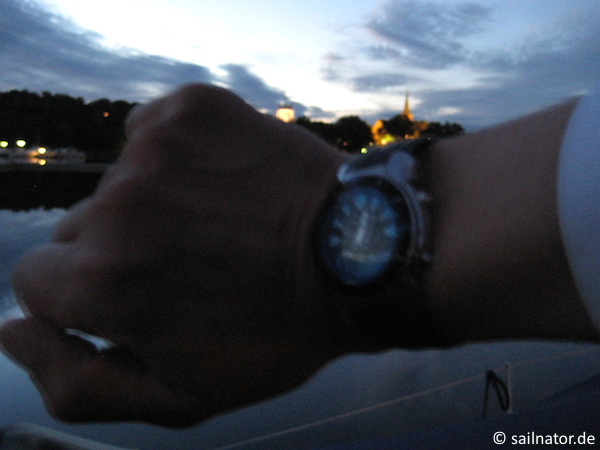
At 00:30 a.m.
Sunday, 15th June
Although the marina of the Arcona shipyard is well protected the north wind has shaken us up properly the whole night. It brought us cold polar air. So, first thing, we turn the electric fan heater on again after getting out of our sleeping bags. We are surprised that only the side windows in the saloon are steamed up a little bit. Apart from that no condensed water is ascertainable because of the foam core that is laminated between the glass-fibre. It obviously insulates very well. Even the bilge is dry as a bone.
To avoid disputes among the crewmembers the skipper takes the right to fetch the rolls from the nice bakers this morning. After breakfast he wants to explain the navigation in this demanding area to us. Already the first view on the chart shocks us. It looks as if somebody has randomly dropped coffee on paper. In between some points are coloured dark blue and others light blue. Everything kind-of looks like the same. The stains differ only in form and size. There are barely striking landmarks that help to orientate. The charts have such a large scale that one does not really get an overview and where to go.
If one navigates through this labyrinth only with map and compass one has to plot all the course lines one wants to sail before leaving the dock. And the degrees should already be written next to it. In the narrow waterways there is no time to calculate them later. And then one has to tick off all the marks and buoys that have been passed because it looks the same everywhere. It is easy to lose orientation. To the left and right there are rocks covered with pines and birches and rocks covered with birches and pines and ahead there are rocks covered with pines and birches. And under the surface there are rocks without pines and birches that are awaiting being hit by a keel. Fortunately nowadays one can use the electronic navigation in addition. It makes everything much easier in this area but it tempts carelessness too. Our skipper installed a chart plotter in front of the helm that he uses besides the paper charts. Additionally he has electronic sea charts and a GPS for his laptop as autonomous backup. In the emergency bag there is also a handheld GPS. But one has to know certainly how all this stuff works. The briefing takes quite a lot of time.
At the end the skipper gives us envelopes where we put in a list of all the medication that we need and a description of our known previous illnesses. This information is important in case of an emergency on sea. A medical doctor can make his decisions with these when he is called over the radio or if somebody has to be rescued by helicopter for example. To offer fair and non-discriminatory treatment even the healthy crewmembers have to deliver an envelope. If everything goes well we get them back closed after the trip. For safety reasons we all store the number of Bremen Rescue in our mobiles. That is the German maritime distress service. They are connected to the Swedish authorities and can translate for us in case of emergency.
The wind decreases considerably after about 11:00 a.m. The sun shines and finally we can leave the dock. Because the wind is expected to come from north during the entire next week we decide to go first in this rough direction. We do not have to beat on our way back then. But actually the journey will be our reward. For a better overview we enter waypoints in our plotter and mark alternative ports and emergency bays in the paper chart. Before we can start the yacht has to be prepared ready for departure. Under deck everything has to be stowed the way that nothing can fall out by waves or when the boat heels. All hatches and seacocks have to be closed. Life jackets and foul weather gear are within easy reach and ready for use. We take the tarpaulins off the furled jib and from the main sail and attach the halyards. Then we distribute the tasks for the un-berthing manoeuvre. After the oil level and the seawater filter are checked we start the engine and have a look if the engine coolant runs.
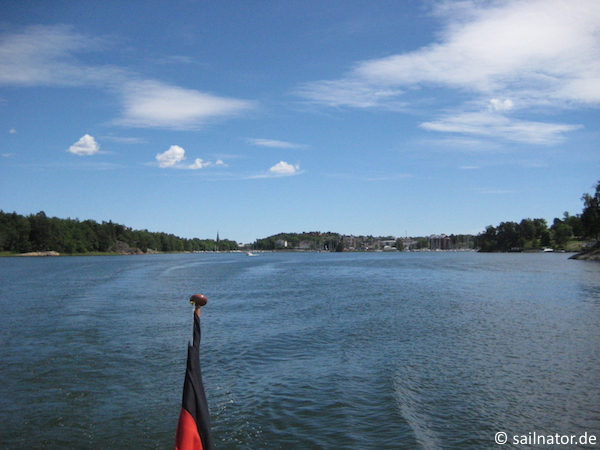
Gustavsberg abaft
At about 11:30 a.m. we leave the dock and the bay of Gustavsberg through its only entrance in a southeasterly direction. The narrow channel is lined by red and yellow wooden houses. In front of them there often is a jetty with a boat. This all could be the scenery of an Astrid Lindgren movie, which we now watch on a very large screen.

Narrow passage
A 22 meters high bridge spans across the sound. It looks as if the antenna would scratch the concrete when we drive down through it with our 17 metres high mast. After a short while we reach the big open water of the Baggensfjärden. But even here we have to meticulously stay in the waterway because left and right of it are large rocks. Some rise out the water, some are partly washed over but most of them are invisible.
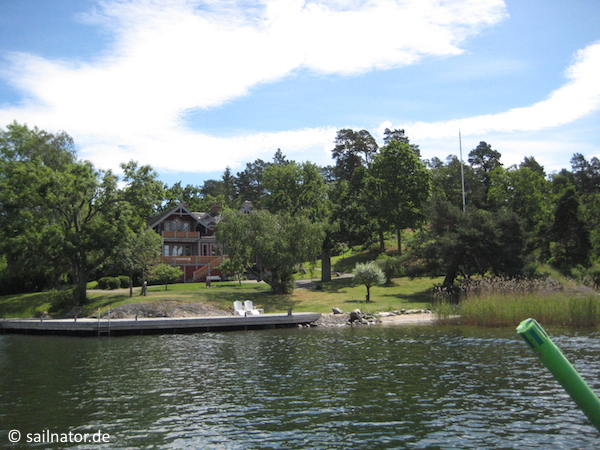
House with private jetty
And then time has finally come: We can hoist the sails. The skipper turns the yacht head up to wind and I go to the mast to do the hard work hoisting the mainsail. The precision work is done in the cockpit with the winch near the companionway. The new sail crackles wonderfully as we pull it up. It looks beautiful in the wind. We bear away and unfurl the jib. Immediately the boat heels and runs forward. We turn off the engine and cut through the water on a close-hauled in 3 to 4 wind forces from southwest.
Because there is nearly no swell and the shore is so close we feel as if we are on a large lake. The sun shines, the water glitters! We trim the sails with barber hauler and traveller. We trim the outhaul and are excited by every tenth of a knot the boat sails faster. The Arcona 340 only has a relatively small jib and compensates the lost sail area with a quite high mast of 17 meters. So she sails excellent in calm winds and at a good angle to the wind. But she has to be reefed early in stronger winds.
Finally there is enough space to practice some man overboard manoeuvres. This way we get a feeling on how to stop the boat precisely. But we do not know how this should work in more narrow waterways – even when the Arcona 340 is really very manoeuvrable and turns in a very tight circle.
We give way to an Optimist regatta. We count about 50 of the small dinghies steered by children. Soon we reach the southern exit of the Baggensfjärden and change our course to southwest. The island of Ingarö stays on port side for a long time and on starboard one small island follows the next. Slowly we get used to the boat and we obtain our sea legs. We enjoy the pleasant journey and for sure everybody wants to be the helmsman once. Endless weekenders come towards us who have to go back to their homeports now. But most of them have already secured their sails and save themselves the beating in the quite narrow waterway.
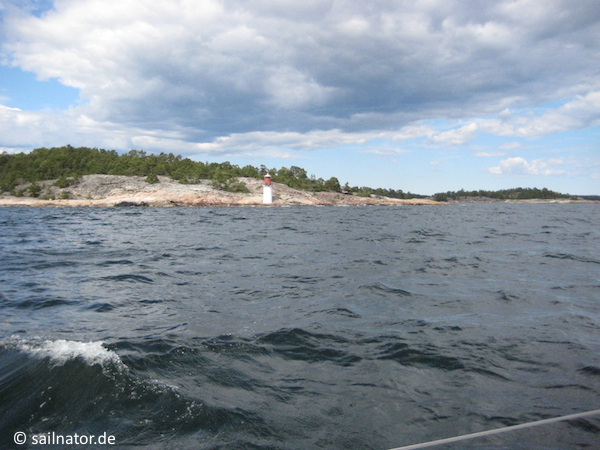
Small lighthouse on Gröno
At about 02:00 p.m. the lighthouse of the small island of Gröno is abeam and we follow the Nämdöfjärden to northeast. We can keep this course now for a long time. The sun shines, we glide over the smooth water and pass the beautiful landscape of the archipelago. From time to time we see some passenger ferries that act as public buses in this area. A big two-master beats towards us but she soon secures the sails and continues her trip by engine. The weekenders on board have to go home now.
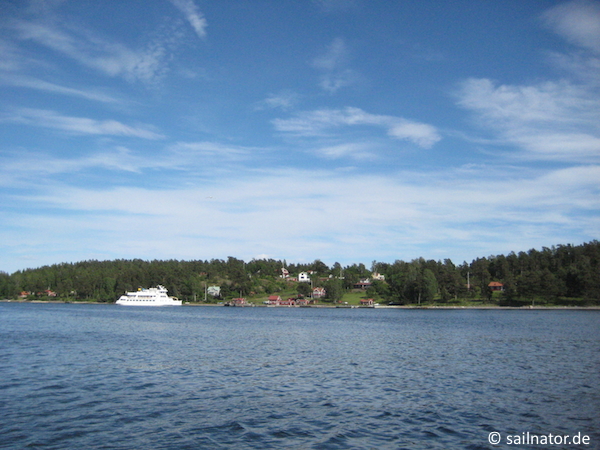
Public transport in Sweden
Slowly the Nämdöfjärden narrow and the small islands come closer again. After we passed the narrowest passage the big water surface of the Kanholmsfjärden opens out in front of us. The wind now blows from abaft and decreases markedly after about 06:00 p.m. Again we are reminded of sailing on a lake. We could start the engine now but we are not in a hurry. The evenings are long and we do not have to get hold of a berth in a marina. And because there is nearly no swell the sails do not flap. Here the Arcona 340 can demonstrate her strength of sailing well in calms winds.
We reach some islands again and are quite close to our anchorage now. There is a soft crackling in the air as if somebody is working with a jackhammer far away. We look around with the binoculars but we cannot find anything. Only when we pass one of the islands very close we recognise that the myriad of ducks that live here make these sounds. We experience a remarkable evening atmosphere.
We secure the sails just in front of our anchorage for the night. It is located between the islands of Säck and Krokholm. The entrance is very narrow and we are surprised that only two yachts are moored at the rocks. We target the shore opposite to them in the southwest, even if the wind turns to northeast tomorrow. The surrounding cliffs are high and we let us be seduced by the smooth water.
We clear up the long mooring lines at the bow and take the anchor with a lead line and 6 meters chain forerun out of the back locker. We put it on the new rocker at the stern pulpit. Now it is ready to drop without damaging the stern. This way it is also easier to pull it up and it is possible to clean anchor and chain before they are returned on deck. In the pilot book the areas where it is recommendable to berth are marked red. There the rocks fall away sharply into the water and it is possible to drive close to the bank.
We head to the place we have chosen and drop the anchor. The man at the bow shows the distance to the shore and when we reach it he jumps on to the rocks with the mooring lines in his hands. But he regrets this immediately because he is not 20 years old anymore and all his bones crack. It would have been only one step forward with the bow ladder but that is still in the back locker. The windward line is immediately fixed on a tree. The skipper has a look if we are berthed well. The place is perfect but the remaining anchor line is too long in his opinion. He fears that the anchor could slip if the wind really picks up overnight. So we decide to try it again. The man on shore stays there.
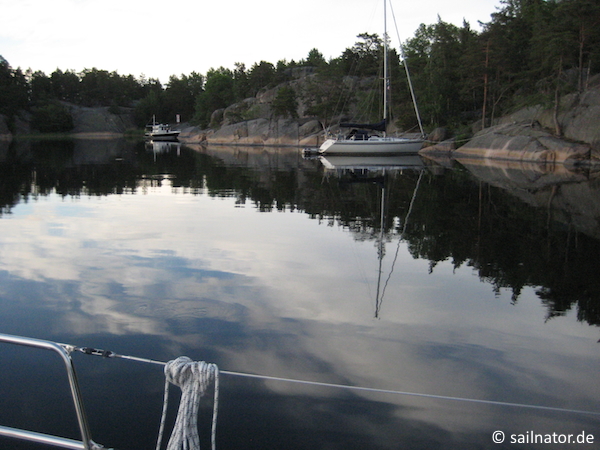
Our neighbours in Säck
The anchor holds extremely securely and we have to break it out by driving backwards. To get the 15 kilos up by hand is not so easy. Again the rocker at the stern proves its worth.
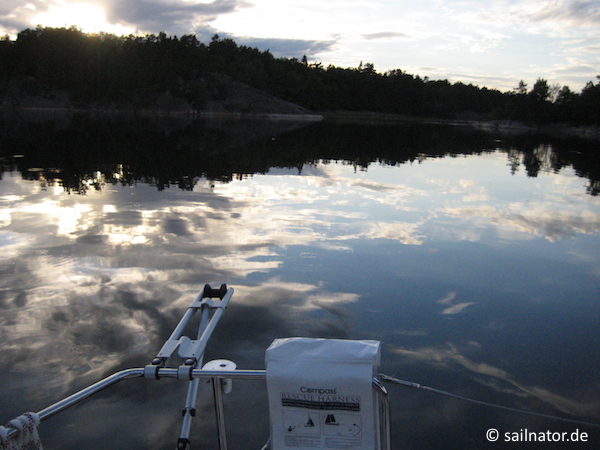
Rocker for the stern anchor
We drive towards the banks again and drop the anchor further out this time. But now the line is too short and we have to extend it with a second one. The man on shore pulls the fore lines around two pines and we cleat them on the bow again. Immediately mosquitoes buzz around us and we just can stop them in time with a special net before they join us under deck.
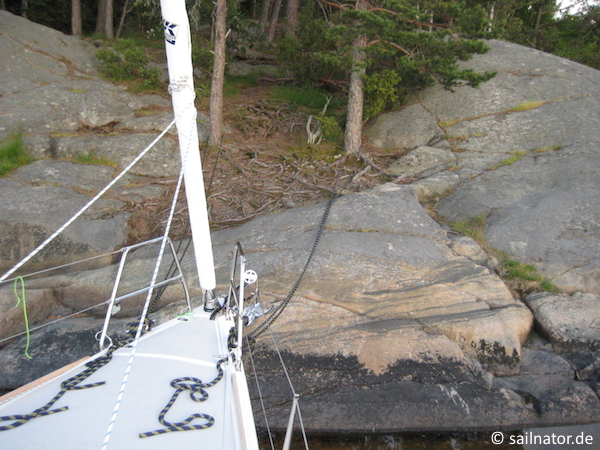
How to moor a boat in Sweden
After a short exploration of the island we get hungry. We cook a nice meal while we watch the mosquitoes and how they try to get through the net in the companionway. We enjoy our dinner inside because it is too cold to sit in the cockpit. After washing the dishes we make ourselves comfortable and turn on the diesel heating. We notice that the wind increases and really turns to northeast. Moreover it also starts raining. The boat begins to sway and small waves slap on the stern. But we have no desire to raise the anchor again now.
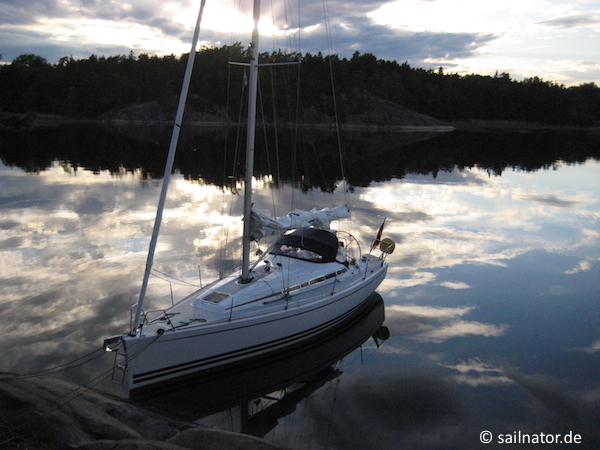
Arcona 340 in Säck
Monday, 16th June
The night was restless and even in the morning a strong wind blows. It rains and so we allow ourselves a lot of time for breakfast. Because it is so uncomfortable outside I do not want to go on shore for the toilet. What is the point of the boat having a black water tank? And then the relief becomes a nightmare. All swims in the bowl but the pump is stuck. After a first shock I move the lever. To pump the water off is still possible, but not to get up seawater and to flush anymore. A view on the transparent hose that is connected to the pump shows the problem. I sucked in a small fish that blocks everything.
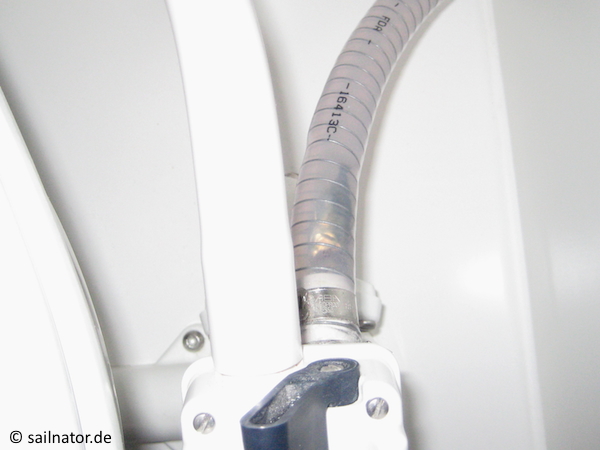
The pump is blocked
I open the hose clamps quickly but for the fish it is too late. Probably its swim bladder burst. Unfortunately it was in the wrong place at the wrong time. If I would have not been lazy about to go on shore it might still be alive.
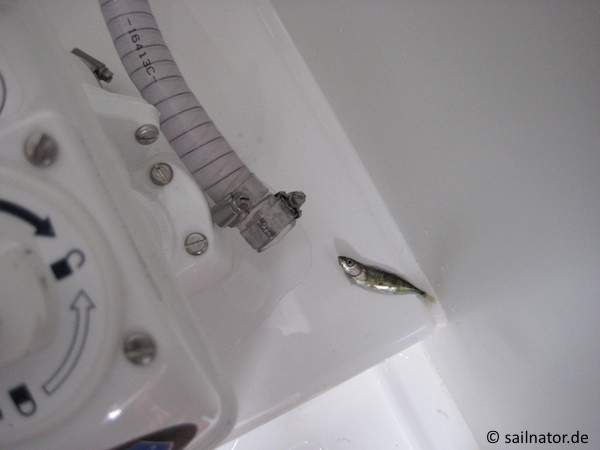
Poor fish
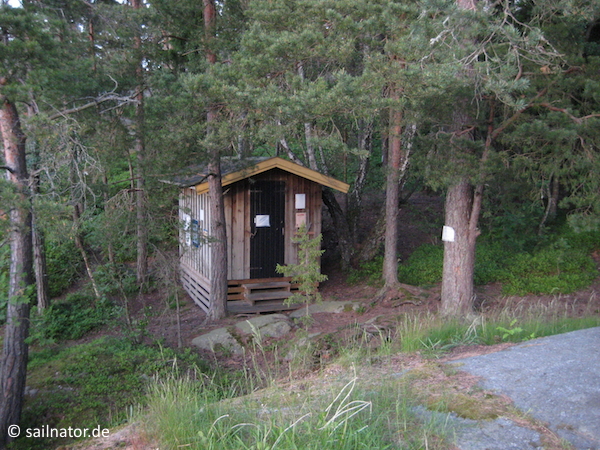
I should have gone there
We only dare to leave about noon when the wind settles between 3 and 4 forces. We have to break out the stern anchor again. As expected we are received by stronger winds outside. Hoisting the sails is already tricky. The second reef immediately follows the first. The jib is kept half furled but still the boat heels strongly. This is actually no problem with the low swell. But what can we do when the wind increases even more? We have nothing to reef anymore. And to beat all day long in these conditions is not such a beautiful thought. „Gentlemen don’t sail upwind!“ And because of that we already look for a sheltered bay. At about 03:00 p.m. we secure the sails again and escape into a bight at the island of Kålö that is protected to the north. But it works differently to our plans: The wind is redirected by the opposite island of Storö and follows us into the anchorage. Never mind. There is no other option around and the deflected waves do not look too high. So we think.
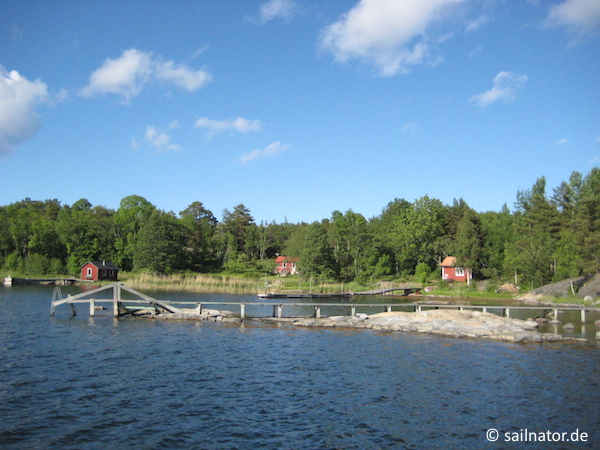
Kålö
A big Swedish sailing club runs a pier in this bay. Yachts have to be moored there on a stern buoy and two forelines to the jetty. We catch the mooring ball with our special hook but when we approach the jetty we realise that our line (20 metre long) is too short.
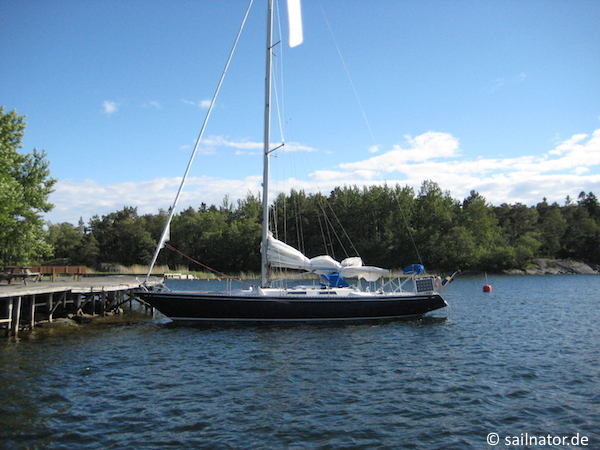
Neighbours in Kålö
Yachts of 30 meters length could berth here. While we extend the line we drift away. Now the long distance to the jetty plays to our advantage. This way we have enough space to steam into the stern line and thus adjust the boat again. That would have even been possible if there was a yacht lying beside us. Shortly afterwards we are moored on the jetty. A Swedish yacht comes in and misjudges the length of the line too. For the mooring ball the Swedish sailors use a snap hock at the end of the line and they do it the same way with the rings on the jetty.
We clear up the deck, look around a little bit and make coffee. Later somebody from the club appears and gives us a friendly welcome. He asks us if he should prepare the sauna later. The skipper accepts the offer with pleasure.
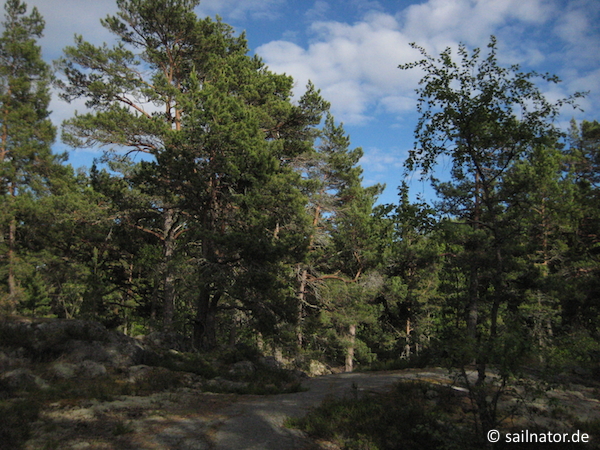
Kålö
Kålö is private property for the most part. Nevertheless we dare to walk along a fence to the other side of the island. The sun comes out again. We go through thick pine-wood forest. To the left and the right of the path blueberries grow. The petals just fall off and small green pearls form. On the shore many different wild flowers bloom. We climb onto the rocks and enjoy the view on to the little islands around and on the open water.
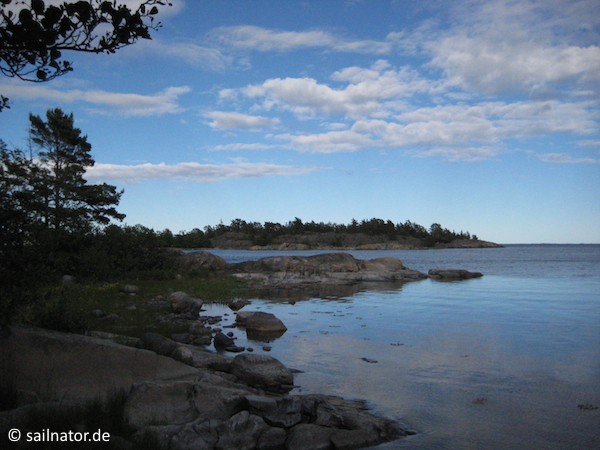
Kålö
Back on the jetty again we notice that the skipper is no longer there. We find him on the highest rock of the island where he sits with his notebook and tries to get the weather report. The wind will increase more overnight and not decrease until tomorrow afternoon.
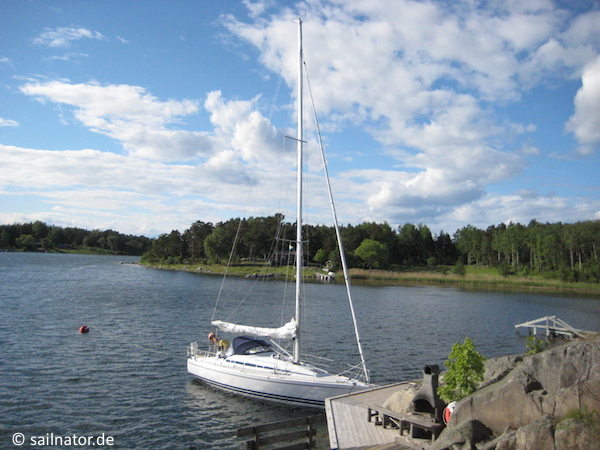
Arcona 340 in Kålö
After dinner the sauna is preheated. The scent of the wood fire lies over the bay. I wash the dishes and clear up the boat while the others sweat. Later on I watch them jumping into the cold water from the jetty. There is a very pleasant evening under deck. Outside it is too cold and windy again. As it seems even the mosquitoes do not like the weather because they stay away.
Tuesday, 17th June
The night was very restless and we nearly do not get our eyes open. But we can take up time because the wind is still too strong and it rains. Nevertheless I take my way to the outhouse today. There shall not be another senseless fish death. I have never sat on a toilet as nice as today. Straight in my line of sight there is a large window with a great view to the bight. Above the loo roll a portrait of the Swedish Queen Sylvia and King Carl Gustav has been placed.
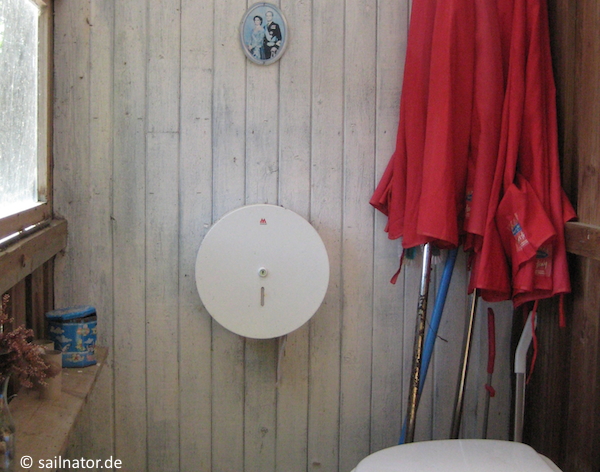
Toilet with great view
It is really uncomfortable outside and only 9 degrees Celsius. Colder than it was on the New Year’s Day in Germany this year. To my mind something is going wrong here. My image of Sweden is influenced by the wonderful summers in the Astrid Lindgren movies I saw when I was a child. There it never rained. The weather today looks like a case of fraud to me.
At about 03:00 p.m. we get a bay-tantrum. It is enough now! We leave the dock. The clouds are low, everything is grey and the rain drums on the deck. This is the perfect opportunity for the foul weather gear to prove its worth. But we are underway at least. We soon reach open water and hoist the sails. To be on the safe side we tie the first reef. A wonderful sailing wind is blowing. The yacht heels and runs away with six and a half knots. If this horrible rain would only stop soon. I am hydrophobic and sit down on the edge of the companionway under the spray hood.
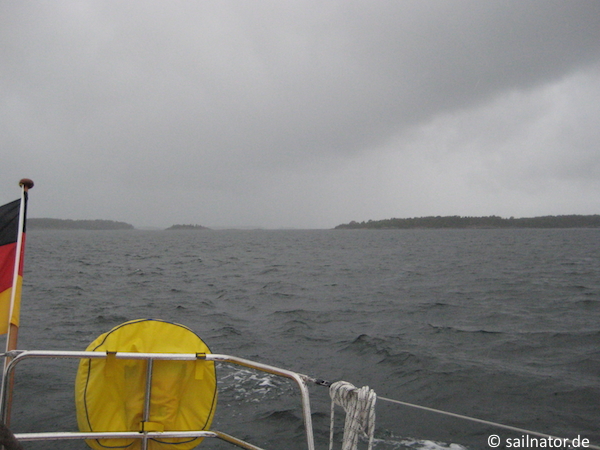
Foul weather
We sail on a north-easterly course. The yacht cuts through the water. Suddenly a red buoy appears on the water out of nowhere. It does not seem to make sense. The skipper looks at the plotter. Hm. To bear away and leave it on port side means to lose height. The helmsman just zoomed out of the electronic chart to get an overview of where to go. In this setting a big light blue spot is around the buoy. That should be enough for our draught. The buoy passes on starboard.
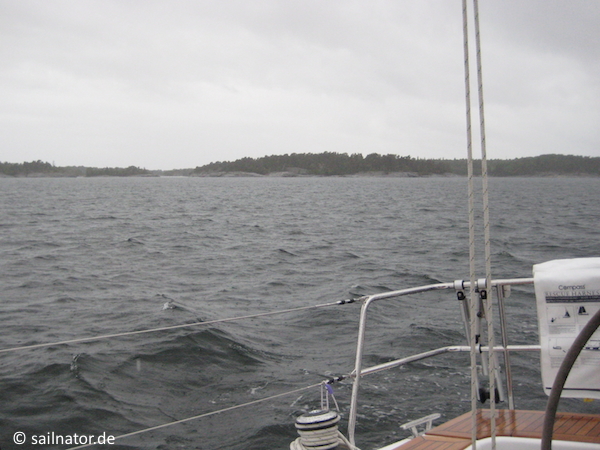
alles grau
Suddenly there is a heavy bang. We go down from six and half knots to zero. Grounded! We lie diagonally on a stone. Nearly in the same angle as we heeled before. We luckily did not hit the rock full frontal, but we are stuck. After a moment of shock the crew awakes. What shall we do now? How do we get off?
My first worry: Do we have ingress of water? It looks chaotic under deck. The kettle flew from the stove to the opposite bathroom door and hit a notch into it. The planks on the floor are wet. The boards that cover the sink jumped up and pushed up the lever of the tap. Now the water runs over the edge of the sink in the salon. The problem is solved quickly. But what does it look like in the bilge? In front of the galley some bottom boards are loose. Beneath them it is wet. But it is sweet water. Probably from the sink. There is no extra water. I look around everywhere but I cannot find anything.
Meanwhile the engine has been started. Fortunately the propeller does not scratch on the rock. We fear for our rudder. If we get free there is the danger that the boat uprights itself when the keel is off the stone. But the rudder might be still above the stone and break off. We carefully accelerate. The boat heels to the front but fist of all nothing else happens. We all go to starboard and give full throttle. The yacht moves, the engine makes some squealing noises and the keel scratches audibly over the stone. The inflatable life raft and the emergency bag lie on deck in case the keel falls off and we capsize. But all goes well. Suddenly the yacht uprights and drives forward. The rudder works! We can return to the old course. But we do not want to hit a rock again now. Where are we actually? And then the next shock: The screens of the plotter and of the depth finder and the log are black. What shall we do now? Hopefully it is not a total blackout. That would mean the bilge pump would not work either. We even cannot shoot up head to wind to secure the sails because we do not know what is there.
So we heave-to. The skipper turns on the notebook and after a short time we have our position. Around us everything is clear. So we can stay like this and look for damages in peace. The question is if we can sail on or better return to the shipyard. The massive lead keel surely has only a bump and that it falls off is quite improbable with the Arcona 340. The keel bolts are not only laminated to the hull, but are also screwed on a steel frame that runs from the front to be back of the bilge. But on closer inspection we have to realise that the laminate flaked off this frame. We do not know how it looks under the boat. There is no water entering in at the moment but it would be very bad if some infiltrates into the glass fibre. So we decide to return to pass an expert opinion at the shipyard.
We turn around and secure the sails to avoid any extra burden for the keel. We cannot find a reason for the blackout of the plotter. There is enough electricity and all plug connectors seem to work. Fortunately the notebook runs and from now on we set our course from the chart table like in old days. After an annoying fumbling-around the displays for the wind vane, depth finder and log light up again but the plotter stays dark.
Now I have the time to have a look into the cupboards. Several plates, cups and glasses are smashed. But the alcoholic drinks under the salon table are intact. Also no pasta sauces or something like that ran out. Lucky us!
It stops raining but it is still cold. The adrenalin level slowly falls and we start to freeze. Nobody wants to be the helmsman now but one of us has to be. We pass several islands but we do not care about them anymore. We are concerned about the boat and our safe homecoming.
Meanwhile it is quite late. We could reach Gustavsberg tonight, but it is not really fun in the cold. We decide to call at the island of Grinda to stay there for the night and to go on tomorrow. To get there we still have to navigate quite some distance through the labyrinth of islands. Finally the harbour is in front of us. The island is a popular weekend spot for people from Stockholm. Again our docking line is too short for the distance between the mooring ball and the jetty and has to be extended. Meanwhile I stand at the bow and talk to the charming female blond harbour master who waits for us. Finally we are moored and the heavy pressure of the past hours falls off us.
We clear the deck and have another look in the bilge. The chipped laminate at the steel frame looks worse than we thought and a little bit water entered – where from is uncertain. It seems to be sweet. But the water in the archipelago is not really salty. We check the water tank, all feeding pipes and the pumps. But all looks well. Let’s wait and see what the technicians at the shipyard say tomorrow.
We dress up to go on shore. Next to the harbour there is a small beach and a café with a large terrace. Probably that looks very nice when the sun shines and is crowded at weekend. Now all is abandoned and empty. It is cold and the sky is grey. The only ray of light is our female harbour master who gives us a smile when we pass her. We are on our way to the local hotel and restaurant Grinda Wärdshus. Although it is Tuesday today the restaurant is filled to capacity. There are people waiting on the terrace for a table. That is too cold for us and too wet. To sit at the bar is much nicer. We do not have to wait too long till we are invited to the guestroom. It is very cosy there and the people are in exuberant mood. In this atmosphere we can easily forget about the shock of the day. We have very delicious halibut.
When we are at the harbour again we climb on the rocks close to the café. From up here we watch a group of restaurant guests that are collected by a water taxi. Then we enjoy the magnificent view on the bay. Unfortunately we have to recognise that the wind turned again and blows now in direction of our stern. In addition to that the swell of the ferries and carriers hit us that pass the island in some distance. It is another restless night.
Wednesday, 18th June
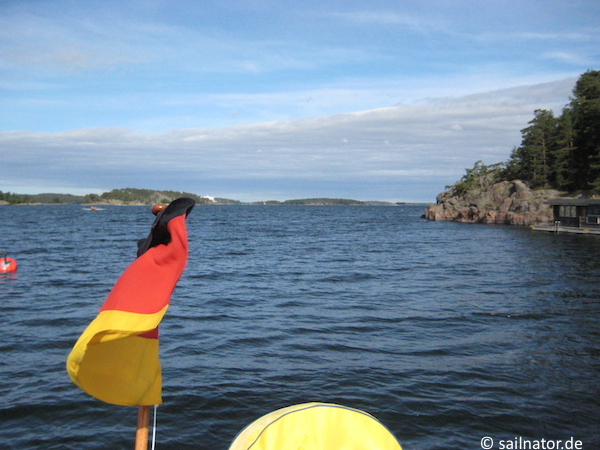
The swell comes directly into the harbour
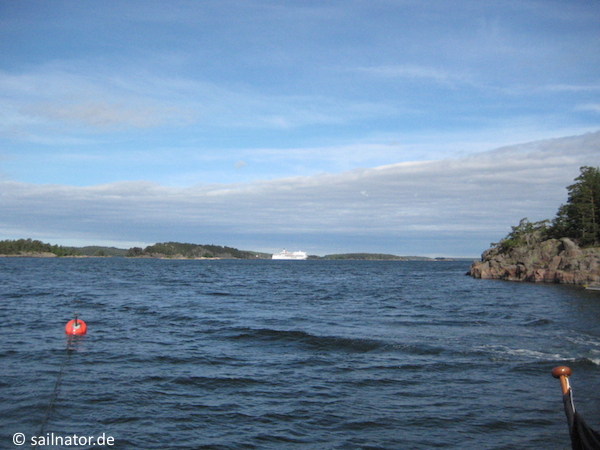
Ferries at the horizon
As planned we leave the dock at about 09:00 a.m. We cross the ferry way and head towards Vaxholm.
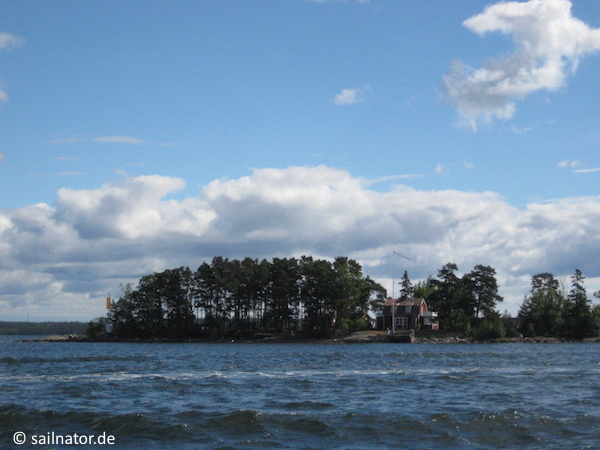
Swedish idyll
Shortly before we reach the village two inflatable dinghies with about 10 passengers each pass us. They all wear black helmets and every time the boat jumps over a wave they nod to us synchronously. It looks really funny.
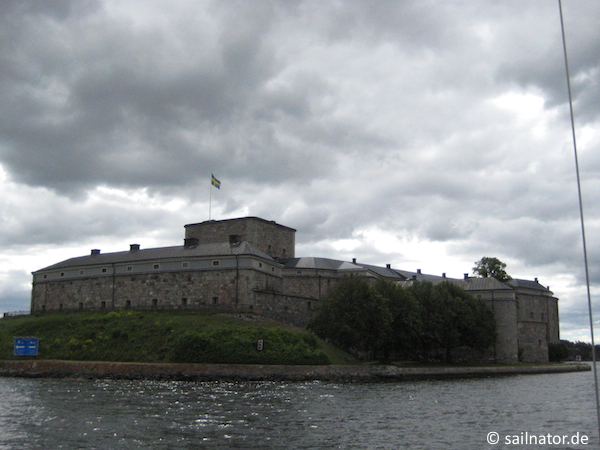
Fortress of Vaxholm
In actual fact pleasure boats should pass the impressive fortress of Vaxholm on the left side. We see the sign too late and can only hope that no passenger ferry comes around the corner now. The town looks nice and we would like to visit it but we have to go on.
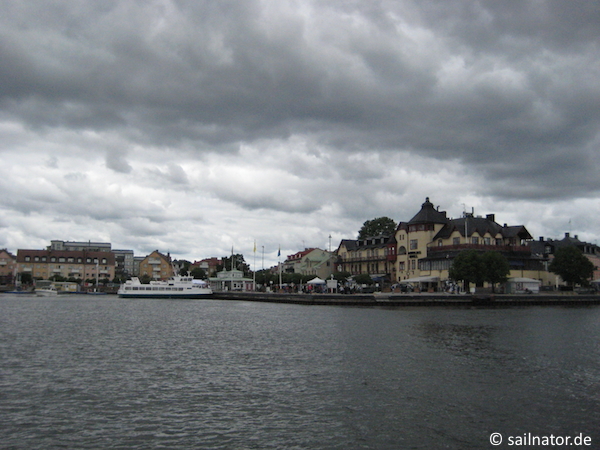
Vaxholm
The closer we get to Stockholm the heavier the shipping traffic gets. At the level of the city district Brevik we make a turn to the south into the narrow Skurusunet. Here we have the feeling of drive through the front yard of local residents.
But it narrows even more.
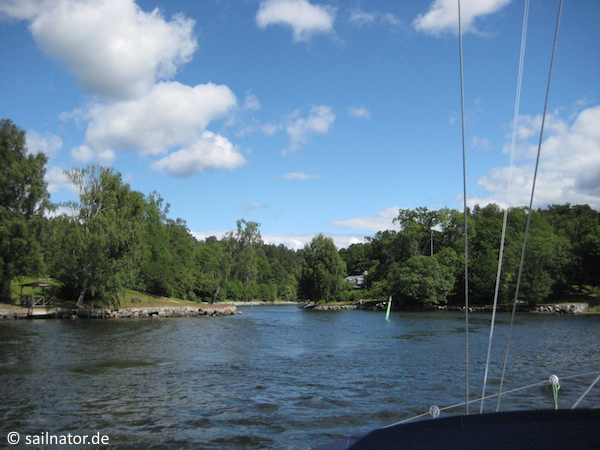
Quite narrow!
From the Lännerstasundet into the Baggensfjärden there is such a thin canal that it seems as if we could gather flowers in the adjacent park. Fortunately there is no oncoming traffic.
Now Gustavsberg is not far away anymore. We berth at about 01:00 p.m. and inform the shipyard about our misfortune. The technical manager is not very concerned after a short inspection. He does not want to lift the boat out of the water. It is easily possible to shut the doors and the lockers. So the boat is not warped and all is not such a big thing. In his opinion we can sail on the next days. But he requests us not to drive on a rock a second time. We are filled with relief.
After a lunch in the bistro and the obligatory visit to the bakery we are strengthened but we still feel tired. The last two nights were very restless and driving by engine in the cold was quite exhausting. We decide to stay here for the night and drive the boat to a safe berth. We have a rest and have a walk afterwards in the beautiful surroundings. Finally we can let the day fade away in the cockpit with a glass of wine.
A little bit tipsy we try again to awake the black screen of the plotter. We check all the menus but we cannot find the mistake. It was not a good idea to let the manual at home on the desk. Just when we want to turn it off the long searched regulator for the brightness appears. One swipe and the chart appears again. Hurray!
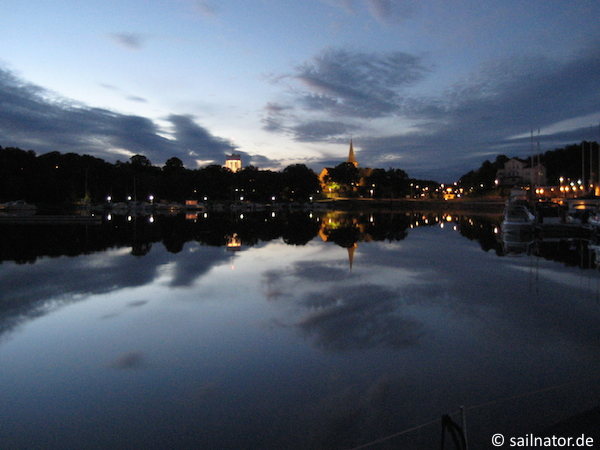
Gustavsberg at night
Of course we want to see where we grounded. We go to the chart layer that was adjusted just before the accident. There is really only a big light blue spot around the buoy. But when we zoom in a small dark blue spot appears around the buoy just where we ran aground. Sh..!
Thursday, 19th June
It rains again. Low clouds dampen our mood. They turn circles over Stockholm on the weather radar. There is no foreseeable improvement. At about 03:00 p.m. we have enough and leave the dock. We already know now the entrance into the Baggensfjärden. When we hoist the sails a heavy rain shower hits us. But the more we get south it clears up.
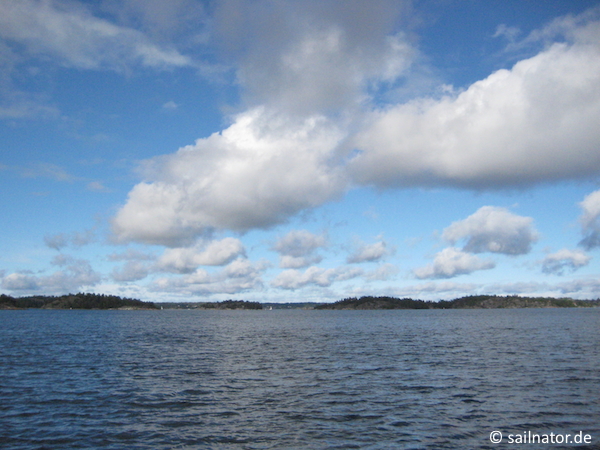
Baggensfjärden
We are overtaken by dozens of powerboats that rock us with their swell. But even a lot of sailboats pass us by engine. It is shortly before Midsummer night and everybody wants to get a good berth with friends in the bights close to the city. We are a little bit concerned about whether we will find a gap between all of them later.
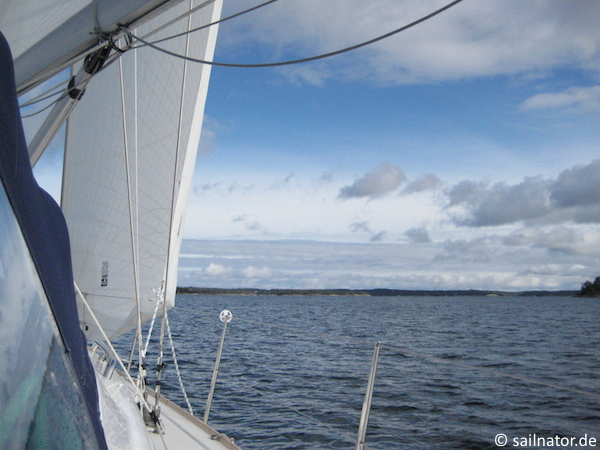
Finally sailing
Suddenly the sky is absolutely blue and wind diagonally from behind pushes us smoothly along the islands. A yacht close to us hoists the gennaker and we see a distress exercise with helicopter and sea rescue boat. Later on a speedboat of the Swedish navy appears that hisses over the flat water.
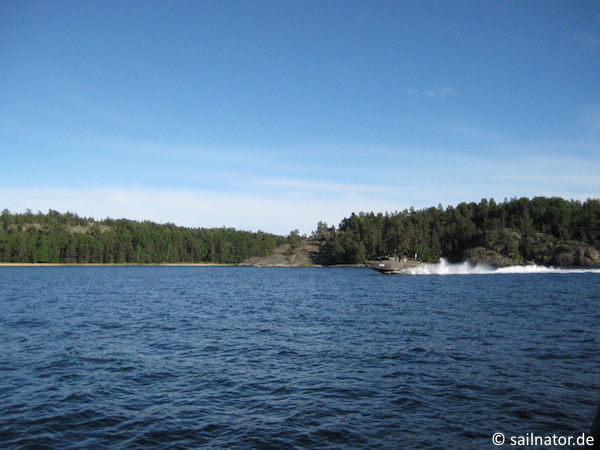
Speedboat of the Swedish navy
At about 08:00 p.m. we reach our anchorage at the island of Ornö
As we feared is it already quite full. The Swedes lie close together with their friends and have barbeque on the rocks in the sun. Even in the middle of the bay some dropped their anchor. But we find a place for us on the side that is already in the shadow now. But it takes some time till we adjust our boat the way that the furled jib fits between the twigs of the pines on shore.
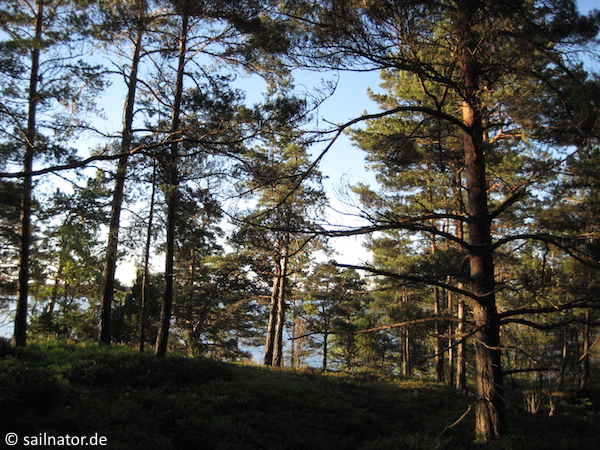
Ornö
First we look around a little bit on the island. On the other side of the peninsula the sun is still shining. We sit down on the rocks and enjoy the view.
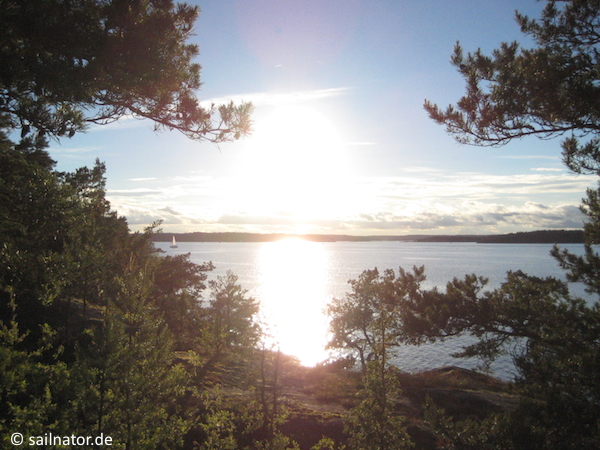
Ornö
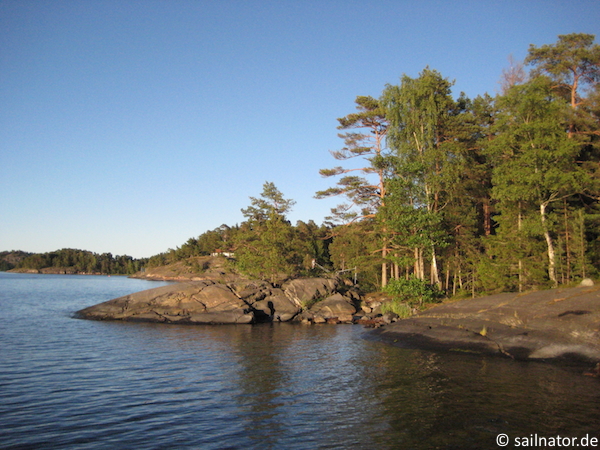
Ornö
When we come back other yachts are moored left and right of us. Deep Viking voices sound beery, children run around on the bank and the smell of the barbeque is in the air. We talk to our neighbours and get inspired by their exuberant mood.
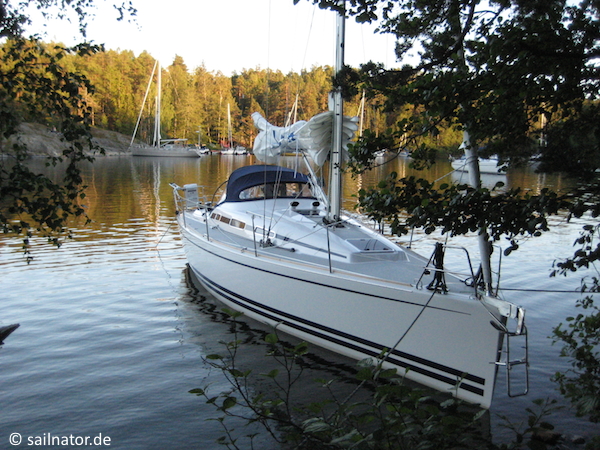
Arcona 340 in Ornö
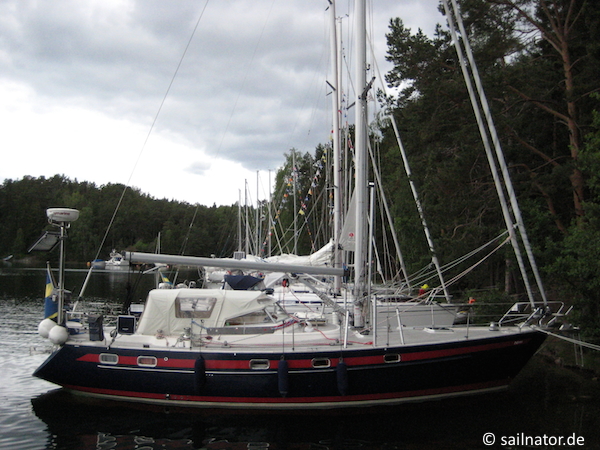
Our neighbours in Ornö
After dinner we go for a walk again. Without the clouds it would still be really light now. Unfortunately it is again too cold to enjoy the evening in the cockpit. The Swedes seem not to be affected by the weather. Their voices sound over the bay the whole night long.

A latecomer
Friday, 20th June
The day begins with sunshine. Even when it is quite cold outside we have breakfast in the cockpit today – the first time on this trip. It seems as our neighbours did not sleep the whole night and they are in a very good mood. We enjoy the day, explore the island again and clear up the deck. After a snack we leave the bay in the early afternoon. Meanwhile the anchorage filled up more and more. The entering boats are happy that we make room for them.
Unfortunately the sky overcast again. We beat against a calm wind to the north. Sometimes a rain shower comes down close to us but we are not hit by them. In all villages at shore we can see festival tents and rock music resounds from there. A helicopter circles above a dark cloud of smoke for a long time.
At about 08:00 p.m. we reach our destination for today: Napolionsviken on the island of Ägnö. The entrance is long and narrow and this anchorage is also well filled. Only one berth next to high and steep rocks is available.
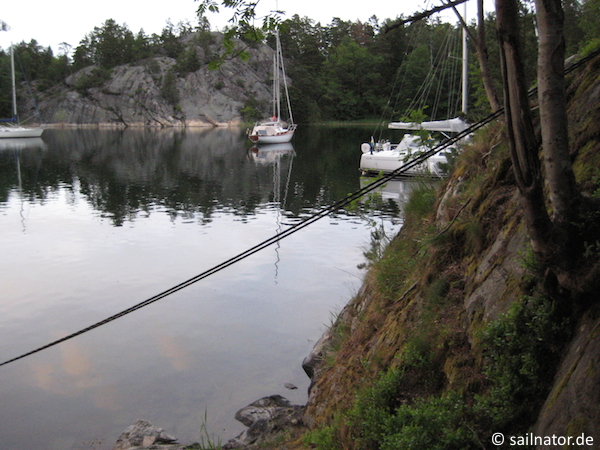
Long foreline
We need two attempts again because we cannot get close enough to the bank at the first try. Then we lie perfect but we have to climb up very high to moor the line on port side at a tree. Furthermore we ended up in the pines with the furled jib again. Their resinous needles are all over the bow now.

Arcona 340 in Napolionsviken
After the deck is scrubbed and cleared up we cook dinner. It is our last evening today and all our remains have to be consumed. We have sausages with potatoes and ketchup. And we destroy the last stock of boozy beverages too. Unfortunately it is actually too cold to enjoy the nice evening atmosphere on deck. So we wrap us in our sleeping bags. That way we sit in the cockpit and listen to the singings of the residents of the island. Behind the hills the smoke of the midsummer fire rises. We have the feeling that it does not want to get dark at all.
Saturday, 21st June
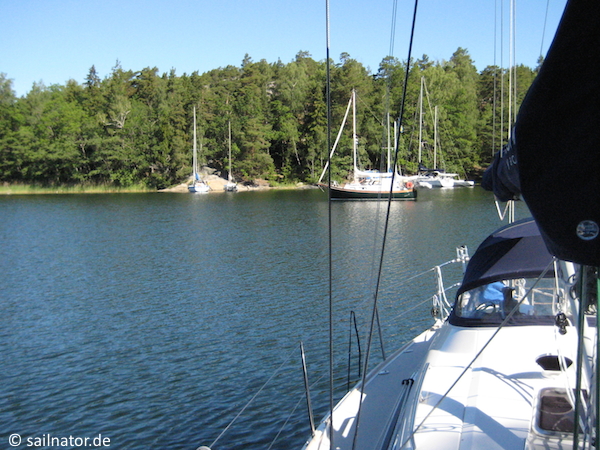
Napolionsviken on the island of Ägnö
Today we already get up at 07:00 a.m. The sun shines and small white clouds are in the sky. At about 09:30 a.m. we raise the anchor out of the mud that sticks on the blades and in the chain now. We turn some laps and clean the tackle by pulling it behind us.

Quite close!
In front of the anchorage we hoist the sails and beat in narrow space further to the north. The wind is fresh and the boat heels in the gusts. Just when we want to reef the wind calms down again. We make it through the passage into the Baggensfjärden and after some beats we reach the small harbour of Saltsjöbaden to refuel.

Small white clouds
There is a rush like at a motorway petrol station at the beginning of the holiday season. Small powerboats speed around, jump the queue and show no consideration for our limited manoeuvrability in the narrow waterway. But everything goes well. We hoist the sails for the last time. We enjoy the wonderful weather and the great feeling to be on the water and berth at about 11:00 a.m. in Gustavsberg.
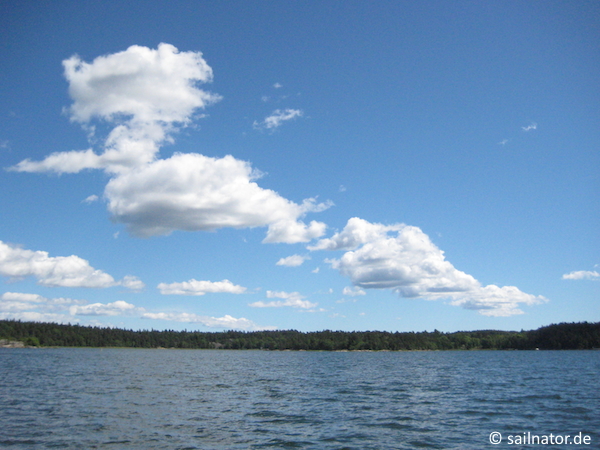
Sun sailing
After we cleared the deck there is still some time to visit our princess at the bistro and to have a coffee at the bakery. Later on we take the bus to Stockholm and from there we go by the Arlanda Express back to the airport. From the window of the starting plane we watch the archipelago and look forward to our next visit!